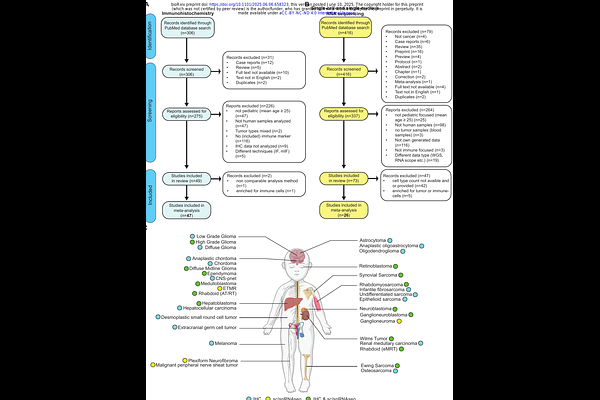The immune landscape of pediatric Brain and Solid Tumors: A systematic review and integration of immunohistochemistry and single-cell RNA sequencing data

The immune landscape of pediatric Brain and Solid Tumors: A systematic review and integration of immunohistochemistry and single-cell RNA sequencing data
Bergsma, F. J.; Koster, J.; Baalman, B.; Mussai, F.; Caron, H. N.; Molenaar, J. J.; Wienke, J.
AbstractBackground: Immunotherapies achieved remarkable success in adult cancers, yet their efficacy in pediatric brain and solid tumors remains limited. Insights into the unique immune landscape of pediatric tumors are crucial to improve immunotherapies for pediatric patients. Methods: We performed a systematic search for studies reporting immunohistochemistry (IHC), single-cell- or single-nucleus RNA-sequencing (sc/snSeq) data on the immune landscape of pediatric tumors. For IHC studies, data on macrophages, T cells, T helper cells, regulatory T cells, NK cells and B cells were extracted. For sc/snSeq studies, cell cluster counts were extracted. 47 IHC studies and 26 sc/snSeq studies were included in the analysis. Results: Our integrative in-depth analysis of 73 studies covered 35 unique pediatric tumor types with 17 tumor types analyzed by IHC, 4 by sc/snSeq, and 14 by both techniques. Regardless of variability in analysis methods, both IHC and sc/snSeq showed that peripheral nerve tumors and soft tissue sarcomas had relatively immune-infiltrated, T cell-rich tumor microenvironments (TME). Brain tumors exhibited a macrophage/microglia-rich, NK cell-infiltrated and T cell-depleted TME. Sc/snSeq data confirmed these observations, showing a macrophage/microglia-rich brain TME. Compared to adult tumors, (CD8+) T cell infiltration and macrophage infiltration was low for all pediatric tumor types. Integrated IHC and sc/snSeq data were visualized in interactive heatmaps, publicly available on R2 as a comprehensive atlas [https://hgserver1.amc.nl/cgi-bin/r2/main.cgi?option=imi2_targetmap_v1; map Immune_landscape_mm2(by patient)_v4]. Conclusion: We provide a comprehensive, integrated overview of the immune landscape of pediatric brain and solid tumors. These insights can aid the development and selection of immunotherapeutic strategies for specific pediatric cancers, tailored to their unique immune characteristics.